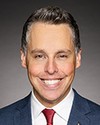[Witness spoke in indigenous language]
[English]
Good day, honourable Chair and members of the committee. Thank you for the opportunity to speak today.
My name is Kendrick Cardinal, and I'm the president of the Fort Chipewyan Métis Nation. I'm here today to share the heavy-hearted impacts the contamination of the big dock in Fort Chipewyan has had on our community environmentally, physically and emotionally. The federal government's failure to meaningfully consult with the community of Fort Chipewyan on this issue over the years has made it even worse. I want to take the opportunity to explain the scope of the harm we've experienced.
The big dock has always been an essential part of our lives in Fort Chipewyan. It's a vital place for us to launch our boats as we head onto the land during the open water season and practise our inherent rights, and it serves as our primary means of escape in emergencies like wildfires. We rely on the water in so many ways, and the thought that we cannot trust the safety of the dock or the surrounding environment is devastating to us.
This issue began with the diesel spill back in 1990 and the subsequent contaminated site designation in 2014 and associated site assessments.
In the letter received this morning from Transport Canada, I was informed that the Fort Chipewyan Métis Nation community was provided technical reports. However, my team has absolutely no proof of these reports. This is extremely concerning given the substantial input the Fort Chipewyan Métis Nation, along with other regional and indigenous communities, provided to Honourable Marc Garneau, the former minister of transport, in 2016 and 2017, during consultation on the creation of the Canadian Navigable Waters Act. In particular, we stated that when the protection of most waters used by rights holders for navigation to carry out their constitutionally protected rights is excluded, it's not only discriminatory, in our view, but contrary to the constitutional requirements of reconciliation.
We requested further engagement with the Ministry of Transport to further discuss our concerns, including those related to having our navigation on and relationship with waterways recognized, respected and protected. That engagement did not occur, and it is clear from recent events that a better, more meaningful relationship and consultation are needed.
In 2023, we learned just how unprepared we were. During the height of a major wildfire in Fort Chipewyan that threatened our community, many of our members were devastated and turned to the big dock as a way to evacuate. Some chose to leave by water, if they were able to pull their boats through the mud and into the water, and headed through their traplines, where they felt they would be safe. However, the water levels were so low that the dock could not be used effectively. This was a dangerous situation, and it could have been avoided had the dock been properly maintained and had the reports come back from the federal government to our community.
This year, our neighbouring nation, the ACFN, reached out to Transport Canada to ask for support, requesting that the dock be dredged so that our community could evacuate safely in the future, yet despite all our requests, no action was taken. This only added to our growing frustration and concern. If the waters become too low, our traditional harvesting areas will be in danger, and the Fort Chipewyan Métis have been found to have the highest wild food diets.
Beyond environmental risk, the biggest toll has been on our mental and physical health. For years, we've lived with the uncertainty of not knowing the full extent of contamination and what it means for our health. Our community already has a higher-than-average rate of rare cancers, and the presence of toxic substances in our environment only adds to that fear. Last year, the situation got even worse. The largest seepage in history from the oil sands added more stress and uncertainty to an already difficult situation.
It's difficult to put into words the kind of stress that comes from living in this constant fear. We are constantly asking ourselves questions. Is it safe to fish here? Is it safe to swim here? Can we drink the water? We should never have to live with this level of uncertainty.
The contamination at the big dock was kept from us for decades. When we finally learned about it, we felt betrayed. We had no idea that such a serious issue was sitting right in the heart of our community.
One issue I want to emphasize today is the trauma that has been caused by all of this, the emotional and mental toll it has taken on our people, mostly our youths and elders. The stress of living in this uncertainty is compounded by the fear that our health and the health of the children are at risk.
We need support to help cope with these mental health challenges. This is not just an environmental crisis. It is a public health crisis as well, and it is one that requires mental health support from an indigenous perspective to address the trauma and fear we've been carrying for so long.
In closing, since Minister Anand took over the transport ministry, she has reached out to our communities, and we appreciate that. We recognize her willingness to work with us. Our hope is that this collaboration continues in a way that leads to real, tangible results, but we are asking for more than just communication. We need action. Our community deserves to live in safety, and it is the government's responsibility to ensure that happens.
The contamination at the big dock cannot be ignored any longer. It's time for the government to take full responsibility, remediate the site and ensure we are protected from further harm.
Fort Chipewyan has been heavily impacted by the Holy Angels residential school, and this is another clear indication of how the federal government has not followed through on reconciliation. The voices of the community of Fort Chipewyan need your immediate attention, please and thank you.
Hai hai. Kinanâskomitin. Have a good day.


